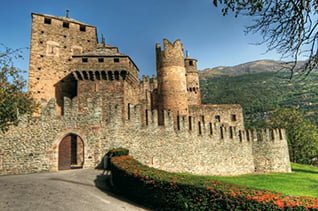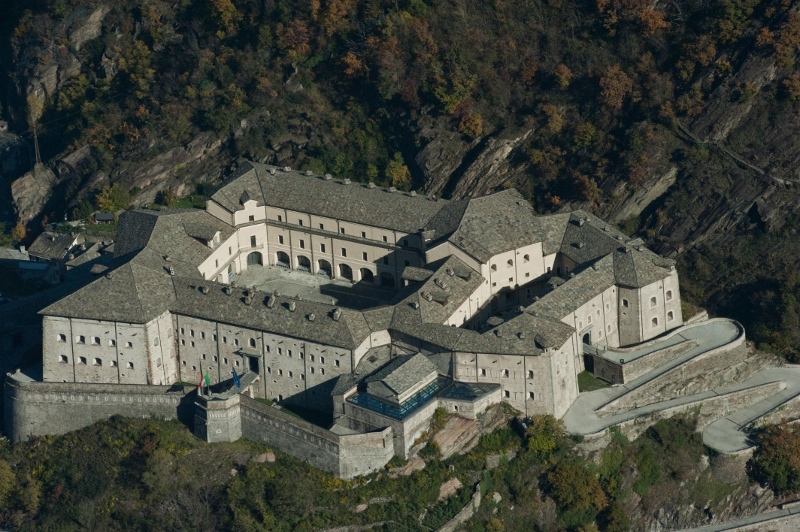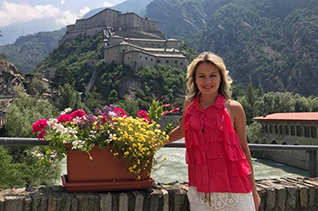Tours to the Aosta Valley castles

Add to your excursion
Castle Fénis

The castle was built in 1340 on the site of Aimone Challant pre-existing medieval buildings. Unlike many other castles built mainly for defensive or military purposes, the castle Fenice is not located on an impregnable mountain, but on a small hill, because it was not used as a military fortification, rather than a symbol of prestige Challant’s house.During the tour you will get an idea of the Savoy family lifestyle.If you take a look at it from above, it is - a pentagon surrounded by round observation towers and high crenellated walls in two rows. In order to get to the second round of the walls, it is necessary to pass through a square tower in the south of the castle.In one of the towers of the castle we can see a dovecote. Before the pigeons were postmen and in case of emergency or war, they would release them, they fly and were able to warn neighbours of trouble or call them for help.Inside the medieval castle superbly painted ancient frescoes, and all its rich decoration of rare wood carvings. Castle Fénis stands proudly over the surrounding area, although it is located at the foot of Mount Saint Julien.
Sarre Castle
 The castle was built on a rock in the village of Sarre in 1710. In 1869 the castle was acquired by the King of Italy Victor Emanuel II, who rebuilt it and used as a residence during the hunting trips.Victor Emmanuel's successor, Umberto I (1844 -1900) also used the alpine castle for hunting trips. On this occasion, the room were decorated with hunting trophies - horns of mountain goats, chamois to celebrate him.
In Sarre it is quiet, nice and cosy. Even the formal portraits of ancestors of the House of Savoy are perceived as family photos. Emanuele Filiberto was the one who allowed French language in Valle d'Aosta to become officially registered.The main attraction of the castle is the main hall and gallery leading to it. Their decoration and design - the embodiment of the hunting passion of kings. Arches and walls decorated with ornaments of Gallery 500 argali horns of mountain goats on the design of the main hall took 969 horns. However, not all animal horns were mined on the hunt. Many simply found they belonged to animals that died a natural death, or killed by an avalanche. These horns were brought to the castle collection rangers and residents who knew about the passion of the king.
The castle was built on a rock in the village of Sarre in 1710. In 1869 the castle was acquired by the King of Italy Victor Emanuel II, who rebuilt it and used as a residence during the hunting trips.Victor Emmanuel's successor, Umberto I (1844 -1900) also used the alpine castle for hunting trips. On this occasion, the room were decorated with hunting trophies - horns of mountain goats, chamois to celebrate him.
In Sarre it is quiet, nice and cosy. Even the formal portraits of ancestors of the House of Savoy are perceived as family photos. Emanuele Filiberto was the one who allowed French language in Valle d'Aosta to become officially registered.The main attraction of the castle is the main hall and gallery leading to it. Their decoration and design - the embodiment of the hunting passion of kings. Arches and walls decorated with ornaments of Gallery 500 argali horns of mountain goats on the design of the main hall took 969 horns. However, not all animal horns were mined on the hunt. Many simply found they belonged to animals that died a natural death, or killed by an avalanche. These horns were brought to the castle collection rangers and residents who knew about the passion of the king. Forte di Bard castle

Forte di Bard - this is one of largest fortification in Aosta Valley, located at the entrance to the valley, in a very narrow gorge. The original castle was built in the XI century (in 1034), and for many centuries served as the "entrance" to the valley. From the title it is clear that this is more a fortress than a traditional fort.In May 1800, a French army of 40 tousand soldiers was stopped by 400 Austro-Piedmontese troops at Fort Bard. They kept this passage for two weeks, highly upsetting Napoleon's plans for a surprise attack on Turin.After having been briefed about the defeat of his troops, Napoleon called the fort as the "evil castle Bard" and ordered to raze it to the ground. Between 1830 and 1838 the castle was completely renovated, until it became property of the region of Valle d'Aosta, by 1990. In recent years, it was used as a prison, but now it is a modern multi-media and interactive Museum of the Alps, hosting permanent and temporary exhibitions, and other cultural events.Down of the Fort we can visit the medieval village of Bard, with its many historic buildings.

At the sausage factory you will taste the most tender Lard in the world, the “mocetta” (beef jerky), neck with juniper, “Bon Bocon” pork sausage, boiled goat sausage, dried meat of mountain goat, brisket "Pancetta".At the winery you’ll taste a delicious red wine, which is also called "mountain brother of Barolo" because it is made by the same Nebbiolo grape varieties.And a typical Aosta Valley "Cheese lunch" in a local farmhouse where you will visit a Fontina cheese production and caves.If you wish, you can extend your tour by paying a visit to the Roman bridge in Pont San Martin (III BC), as well as having a walk along the Gallo-Roman road in Donnas, carved in the rock over a mountain gorge.
Savoy Castle

The castle built between 1899 and 1904, Savoia Castle in Gressonay-St-Jean was where Queen Margherita, widow of King Umberto I, lived for many summers up to 1925, the year before she died. After some resistance from Umberto I, who preferred to stay in the Castle of Sarre for long hunting trips, Queen Margherita obtained permission to build her holiday home.The Castle is actually a large three-storey villa in an eclectic style, characterized by the five neo-Gothic towers.Carlo Cussetti realized the multitude of windows, mullioned windows, mullioned windows and the variety of styles, give it a rather homogeneous and harmonious appearance.The tour is divided into two parts: the ground floor and the main floor.The first one has a main entrance leading to a large hall, with recreation rooms and sitting rooms on one side. On the opposite side is the dining room, richly decorated.The main floor opens up with a wooden staircase bearing griffins and eagles and leading to royal apartments, preceded by a hall.The queen’s apartment undoubtedly occupies the most privileged position; from the windows one can see Mount Rosa and the whole valley in all their splendour.
Sarriod de la Tour Castle

The original castle was typical of the style built between the X and XII centuries. It was originally composed by one tower, over the years it has been expanded several times until the XV century, when it acquired its current appearance.It is the result of the assembly of several buildings dating back to different historical eras, including large curtain walls. Around the massive central tower, which is a classic example of a donjon, a fortified residence was developed in a flat area surrounded by gardens and orchards.The castle was extensively revised by Jean de la Tour in 1420 and then by his son Antoine, the Sarriod family were politically linked to the powerful Bard family in the County of Savoy. The castle still retains significant fragments of frescoes from the XV century. The room known as hall of heads is decorated with 171 carved figures, sometimes grotesque and licentious, which are a curious testimony of medieval imagination.In 1478 Antoine Sarriod de la Tour refurbished the chapel dedicated to the Virgin Mary and Saint John the Evangelist, by having painted the external frescoes of the Crucifix and Saint Christopher and caused to be built the small bell tower. This frescoes now are the oldest and most striking examples of figurative art in the Aosta Valley.The castle remained the property of the Sarriod de la Tour until 1923, then went to the Bensa family of Genoa. It has been property of the autonomous Region Aosta Valley since 1970.
Issogne Castle

The castle of Issogne is a beautiful mansion of the late 15th century, belonged to the Challant family. But this wonderful castle has also a sad story. It seems that on moonlight nights the diaphanous figure of Bianca Maria Scapardone, the first wife of René of Challant, moves in the courtyard holding a head and tries to kiss men…just only if they are handsome and young!In the early Middle Ages, on the site of Issogne Castle, there was already a huge villa, which was rebuilt for the needs of the bishops of Aosta. In XIV in Aimone Challant, the owner of the Verres castle, captured the castle of Issone, he turned the harsh bishop's residence into an elegant castle in the Gothic style. Later, between 1490 and 1510, thanks to Giorgio di Challant, abbot of the monastery of Sant Orso in Aosta, to the castle was given a modern look.New buildings were connected to the existing main building and formed a single complex in the shape of a horseshoe. The entrance to the palace is through the courtyard, which shows the emblems of the Challant family. In the centre of the courtyard there is the famous wrought iron fountain in the form of pomegranate.

The portico is decorated with frescoes depicting everyday scenes (guard squad, baker's shop, fruit and vegetable market, spice seller and grocery store - this is the earliest images of the famous Fontina cheese).The graffiti of the castle found in the chapel and in all castle can be considered ritual and performative acts, visually documenting conversations among diverse audiences in the late medieval and early modern periods. At the castle, visitors inscribed graffiti on figures and scenes to represent their responses to key social issues.On the ground floor there is a dining room furnished with furniture of the 15th century, a kitchen, a hall of Justice, a large fireplace decorated with a family coat of arms and frescoes with hunting scenes and the “Court of Paris”.On the second floor are the rooms of the Countess and Count Renato, a chapel with lancet vaults and frescoes.On the third floor there is a room of the "king of France", room of the Cavaliers of St. Maurizio is decorated with a beautiful coffered ceiling with a cross of this order.





